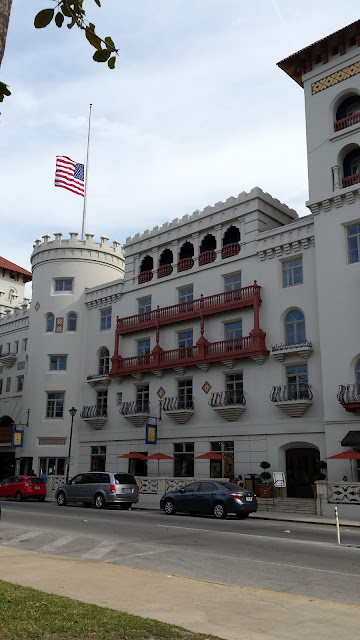#2 Florida Trip - St. Augustine
I left Jacksonville and headed south to St. Augustine where I had reserved a Bed and Breakfast
for the next two nights near the Old Town so that I could explore on foot this old city I had long wanted to see. I must admit my initial reaction was that it was very touristy with lots of little souvenir shops and the like, but I soon came to really enjoy walking the old streets and learning a bit about its history. I enjoyed sketching here as well and will start with a few sketches from my watercolor journal. See if you recognize their names when you see the photos! Click on the photo to see the whole image.
Pages from my Sketchbook / Watercolor Journal:
Now the Photo Essay:
 |
| My comfy BandB "Southern Wind" in St. Augustine |
 |
| Castillo de San Marcos which dates from the 1600s is the largest most complete Spanish fort in the U.S. |
 |
| I enjoyed wandering along the picturesque streets of Old Town |
 |
| Tapas and Sangria made a tasty lunch! |
 |
| The Tower of the Cathedral Basilica of St. Augustine |
 |
| Interior of the Cathedral surprised me with its red ceiling! |
 |
| Casa Monica is one of the oldest hotels in the U.S. first opened in 1888 |
 |
| The most impressive campus of Flagler College opened in 1888 as the Ponce de Leon Hotel |
 |
| The Lightner Museum, formerly the Alcazar Hotel, a museum devoted to the collections of the Gilded Age. |
 |
| Staircase inside the Lightner Museum |
 |
| Above two photos, the Villa Zorayda Museum, built in 1833, is a 1/10th scale replica of the Alhambra Palace in Spain. |
 |
| Ximenez-Fatio House built in 1797 as the home and store of a Spanish merchant. The House has been owned and managed by women since the early 1830s, an era when it was unusual for a woman to own property or earn a paycheck. These astute businesswomen used their household management skills to earn a living. In the process, they set the standards for modern tourism, the backbone of Florida’s economy today. The following photos were taken inside the house. |
More images of Old St. Augustine:
 |
| The Oldest Wooden School, built before 1888. |




















Comments